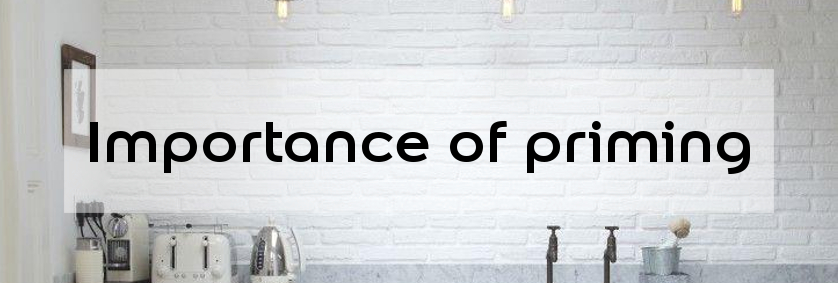Importance of Priming - Guide
You will know its mostly good practice to prime any bare surface before applying paint, but you’re probably confused by the number of primers on the market, and what should be used where?
The main benefit of a primer is to even out the porosity of the surface and ensure optimum adhesion so that you get the best possible results from your paint system, but other features might include stabilising a powdery surface or helping to prevent stains ruining your decoration.
Note: You may also be confused by the various terms used, and what the difference is between primer a sealer and an undercoat. While some manufacturers add to the confusion, it may be worth offering a general explanation.
Primers are used on bare surfaces (e.g. wood and metal) and are usually white or off-white, sealers are used on plaster or masonry and are normally clear or only lightly pigmented, and undercoats (sometimes called mid-coats) are used onto coated (primed or painted) surfaces and are always pigmented.
The terms often get mixed up and depending on where you are in the UK, you might use alternative terms. Just to confuse matters further, we also have primer/undercoats and primer/sealers, which do both jobs!
We have outlined the major benefits of priming (or undercoating), and when (and where) you may need to use a specific product. We’ve also given you a link to some of our tried and trusted “priming” products to help you make the right choice, and you can find our full range of “primers” here.
When do I need a “primer” for internal walls/ceilings?
The easy answer would be “always”, particularly on bare surfaces, but of course it’s not that simple.
Surfaces that are already painted and in good condition can simply be over coated (after cleaning and a light sand). Always use matt paint as an “undercoat” if there is a dramatic colour change, even if you are finishing with soft sheen or silk.
You should only need a specific primer if the surface you're going to be painting is:
Chalky/powdery
Has staining (e.g. water stains, nicotine, marker pens, etc.)
Is highly alkaline (you may see surface salts)
Bare plaster that is drying out should be coated with a breathable finish such as Dulux Trade Supermatt.
Bare plaster that is fully dry may be “primed” with a thinned first coat of Vinyl matt (“Mist coat”). Filled sections should be dealt with in the same way (i.e. patch-primed). Bare plasterboard should be primed with Dulux Trade Drywall Primer Sealer.
Painting Bare Wood
Bare wood is not only porous, but because of its grain variations and the possible presence of knots or filler, absorbs at variable rates, and should always be primed.
As well as providing the best possible adhesion, priming evens up the variable absorption, giving you a uniform surface to ensure consistent performance from the finishing system (undercoat/finish). We recommend using Dulux Trade Quick Dry Wood Primer Undercoat.
Previous Coat is Glossy
Paints do not stick well to glossy surfaces, whether already painted or not. Whether it’s a wall or woodwork, it should be thoroughly sanded to provide a surface “key”. You may need an undercoat for wood, but there is no need to apply any primer, as the surface is already painted.
If it is not practical to sand down to remove the sheen, an “adhesion” primer like Zinsser B-I-N will help your paint bond to the surface. It has the additional benefit of blocking stains and odours.
Painting over a dark colour (with a pale one)
This can cause a headache for both walls and woodwork. If the previous colour was dark, this has can ‘grin’ through the new pale finish, meaning you may need an extra coat or two. This can be avoided by obliterating the dark shade using an undercoat on woodwork and a coat of a pale Matt wall paint on the walls. Of course, this also works if you are painting over a pale shard with a dark one, you just use a dark undercoat/matt instead.
If the problem is a dark “stain” which could bleed into the finish, we would recommend our Polycell Trade Stain Block Primer or Zinsser B-I-N for most interior walls.
Painting External Masonry
For exterior masonry, surfaces can variously have a high pH level (alkaline), be chalky/powdery, or staining, which can cause adhesion problems and discolouration of the finish. While in most cases, if the surface is sound and dry, there is no need for a primer, but when you need one – use one.
A specific masonry primer such as Dulux Trade Alkali Resisting Primer will allow you to safely paint over a wider range of pH levels without risk of adhesion loss, and we would recommend Dulux Trade Weathershield Stabilising Primer to prime/seal unstable areas.
Priming FAQs
"Should I prime metal?" - Untreated metal requires a primer to seal it from exposure before any other paint may be applied. In certain circumstances, specialist primers will be required, for general metal work we recommend Dulux Trade All Purpose Primer
"Do I have to prime my ceiling?" - Ceiling paint can crack, peel or appear chalky if you don't prepare the surface properly especially in problem areas like kitchens and bathrooms, so we would recommend Zinsser Ceiling Pro to be safe against any issues.
"Can I prime or paint over wallpaper?" – Yes, we specifically recommend Zinsser Wallpaper Cover Up for this, as it is a high-quality all-in-one primer, sealer and stain blocker. This seals the wallpaper protecting it from the moisture in the paint and once dry, this one-coat system creates a new surface that’s easy to paint.


 Subscribe to RSS feed
Subscribe to RSS feed
